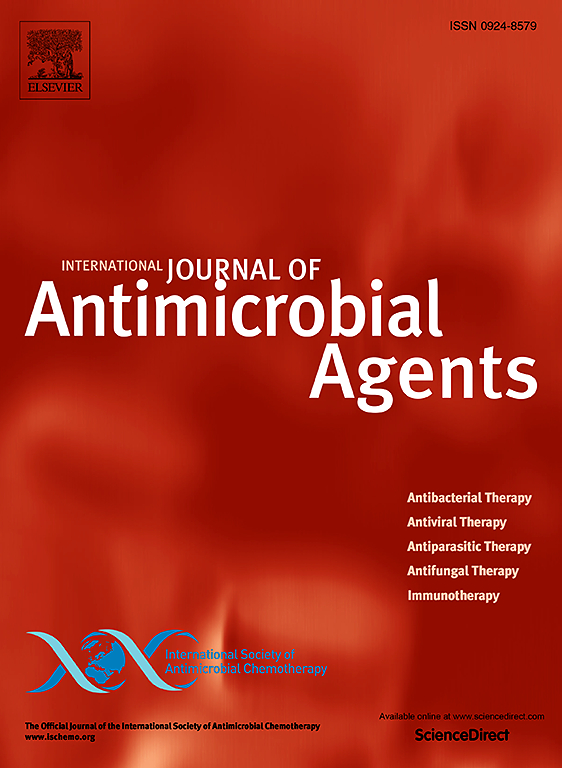Transgenerational gut dysbiosis: Unveiling the dynamics of antibiotic resistance through mobile genetic elements from mothers to infants
IF 4.9
2区 医学
Q1 INFECTIOUS DISEASES
International Journal of Antimicrobial Agents
Pub Date : 2025-02-05
DOI:10.1016/j.ijantimicag.2025.107458
引用次数: 0
Abstract
Objectives
The initial microbial colonization of the gut is seeded by microbes transmitted from the mother's gut, skin, and vaginal tract. As the gut microbiome evolves, a few transmitted microbes persist throughout life. Understanding the impact of mother-to-neonate gut microbiome and antibiotic resistance genes (ARGs) transmission is crucial for establishing its role in infants' immunity against pathogens.
Methods
This study primarily explores mother-neonate ARG transmission through 125 publicly available fecal metagenomes, isolated from eighteen mother-neonate pairs.
Results
The core ARGs, detected in both mothers and their respective infants at all stages (birth, 1st, 2nd, 3rd, 4th, 8th and 12th months) included aminoglycosidases APH(3′)-IIIa, Bifidobacterium adolescentis rpoB mutants conferring resistance to rifampicin, β-lactamases CblA-1, CfxA2, multidrug resistance gene CRP, diaminopyrimidine resistance gene dfrF, fluoroquinolone-resistance gene emrR, macrolide; lincosamide; streptogramin resistance gene ErmB, ErmG, macrolide resistance gene Mef(En2), nucleosidase SAT-4, and tetracycline-resistance genes tet(O), tet(Q), and tet(W). Most of these infants and mothers were not administered any antibiotics. In infants, ARGs were predominantly carried by Bacillota, Pseudomonadota, and Actinomycetota, similar to the mothers. The dominant ARG-carrying opportunistic pathogens were Escherichia coli, Klebsiella, and Streptococcus, found across all infant cohorts. All the core ARGs were associated with mobile genetic elements, signifying the role of horizontal gene transfer(HGT). We detected 132 virulence determinants, mostly E. coli-specific, including pilus chaperones, general secretion pathway proteins, type III secretion system effectors, and heme-binding proteins.
Conclusions
Maternal-neonate transmission of ARGs along with possible nosocomial infections, mode of delivery, breastfeeding versus formula feeding, and gestation period, must be considered for mother-neonate health.

跨代肠道生态失调:揭示抗生素耐药性的动态通过移动遗传元素从母亲到婴儿。
肠道最初的微生物定植是由母体肠道、皮肤和阴道传播的微生物播种的。随着肠道微生物群的进化,一些传播微生物会持续一生。了解母婴肠道微生物组和抗生素耐药基因(ARGs)传播的影响对于确定其在婴儿对病原体免疫中的作用至关重要。本研究主要探讨了从18对母亲-新生儿中分离的125个公开可获得的粪便宏基因组对母婴ARG传播的影响。在出生、第1、2、3、4、8、12个月的母亲和婴儿中检测到的核心ARGs包括氨基糖苷酶APH(3′)-IIIa、利福平耐药的青少年双双杆菌rpoB突变体、β-内酰胺酶CblA-1、CfxA2、多药耐药基因CRP、二氨基嘧啶耐药基因dfrF、氟喹诺酮类耐药基因emrR、大环内酯类;lincosamide;链脲素耐药基因ErmB、ErmG、大环内酯类耐药基因Mef(En2)、核苷酶SAT-4和四环素耐药基因tet(O)、tet(Q)和tet(W)。这些婴儿和母亲中的大多数没有使用任何抗生素。在婴儿中,ARGs主要由杆菌门、假单胞菌门和放线菌门携带,与母亲相似。主要携带arg的条件致病菌是大肠杆菌、克雷伯氏菌和链球菌,在所有婴儿队列中均有发现。所有核心ARGs均与移动遗传元件相关,表明其具有水平基因转移(HGT)的作用。我们检测到132个毒力决定因子,主要是大肠杆菌特异性的,包括菌毛伴侣蛋白、一般分泌途径蛋白、III型分泌系统效应蛋白和血红素结合蛋白。产妇-新生儿ARGs传播以及可能的医院感染、分娩方式、母乳喂养与配方奶喂养以及妊娠期,都必须考虑到母婴健康。
本文章由计算机程序翻译,如有差异,请以英文原文为准。
求助全文
约1分钟内获得全文
求助全文
来源期刊
CiteScore
21.60
自引率
0.90%
发文量
176
审稿时长
36 days
期刊介绍:
The International Journal of Antimicrobial Agents is a peer-reviewed publication offering comprehensive and current reference information on the physical, pharmacological, in vitro, and clinical properties of individual antimicrobial agents, covering antiviral, antiparasitic, antibacterial, and antifungal agents. The journal not only communicates new trends and developments through authoritative review articles but also addresses the critical issue of antimicrobial resistance, both in hospital and community settings. Published content includes solicited reviews by leading experts and high-quality original research papers in the specified fields.

 求助内容:
求助内容: 应助结果提醒方式:
应助结果提醒方式:


